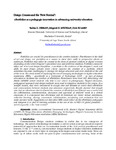Design Courses and the ‘New Normal’: ePortfolios as a pedagogic innovation in advancing university education

View/
Date
2021-06Author
DEBRAH, Ralitsa D.
M’RITHAA, Mugendi K.
NG'AMBI, Dick
Metadata
Show full item recordAbstract
Portfolios are crucial for practitioners in the creative industry. Practitioners in the field of art and design use portfolios as a means to show their skills to prospective clients or audiences. Portfolios may either be created in the form of physical artifacts or digital versions depending on the artist/designer’s specialised area and preferred medium. Portfolios cannot be taken out of art and design disciplines. A portfolio is the evidence of the designer’s work and skills. In most design schools every course requires the creation of a portfolio, which sometimes becomes challenging to manage for design educators and even students at the end of the term. The study aimed at exploring the use of emerging technologies in higher education institutions (HEIs) – specifically in a University of Technology (UoT) – as part of design education to facilitate the creation of ePortfolios. Participants were level 300 Advertising and Media (AD&M) option students who take a core course in photography. Flipped classroom, pedagogical approach and design methods were used to introduce students to the course. In a sandpit session, they were introduced to Google sites and Edmodo to create their ePortfolios and conversations between students and educators respectively. Results showed that Google sites had an affordance that facilitated the creation of ePortfolios and Edmodo was a useful tool for collaboration, communication, discussion and appraisal of students’ work in a virtual classroom. It is anticipated that ePortfolios will be beneficial for future virtual exhibitions, reflective learning, sharing, assessment, collaborations, monitoring and evaluation that can make learners work. Suggestions are that other HEIs could reflect on the ePortfolios pedagogies and integrate it as part of learning activities in the era of the COVID-19 global pandemic – which arguably, is the ‘new normal’.
